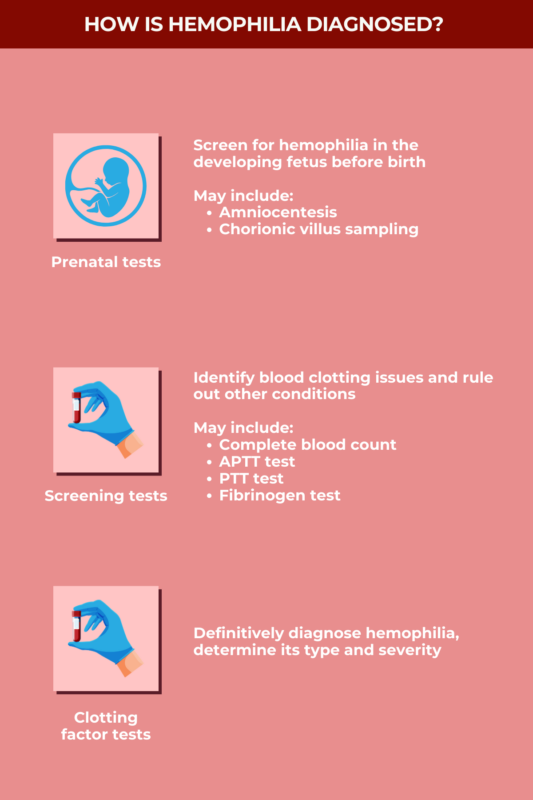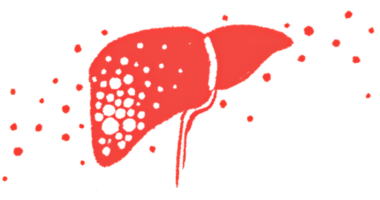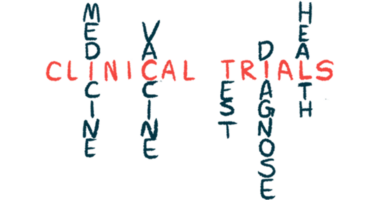Hemophilia diagnosis and testing
Hemophilia is a disorder wherein the blood is not able to clot properly. As a result, patients bleed easily, and it’s unusually prolonged and heavy.
Hemophilia is caused by the lack of clotting factors, that is, specific proteins needed for blood to clot. Each type of hemophilia is marked by a deficiency of a different clotting factor — factor VIII (FVIII) in hemophilia A, factor IX (FIX) in hemophilia B, and factor XI (FXI) in hemophilia C. In most patients, low clotting factor levels are caused by a genetic mutation, though in rare cases hemophilia may also arise due to an immune system malfunction.
Blood tests that look for unusually low clotting factor activity are the main way to confirm a diagnosis of hemophilia.
Because most hemophilia cases are caused by genetic mutations inherited from a person’s parents, an assessment of family history is often an important step in diagnosing the disease. When a family history isn’t present, which is estimated to occur in about a third of babies eventually diagnosed with hemophilia, excessive and easy bleeding and bruising may prompt a test for the condition.
Family history
About two-thirds of people with hemophilia have a family history of the disease. As such, determining that a person has a family history of hemophilia is often a key step in diagnosing the disorder.
Hemophilia A and B are inherited in an X-linked pattern, meaning the diseases mainly affect boys and men as they have only one X chromosome. Girls and women who have two X chromosomes, one with a hemophilia-causing mutation and one without, are known as carriers because they don’t usually develop serious hemophilia symptoms but can still pass the disease-causing mutation to their children. Hemophilia C is inherited through different patterns and people of any sex can be carriers.
For people with a family history of hemophilia who wish to have children, genetic testing and counseling can determine the risk of passing along a disease-causing mutation.
When a family history is present, testing during pregnancy can see if the developing fetus will have hemophilia. These tests involve collecting a sample of fetal cells, which are examined to see if they harbor hemophilia-causing mutations. Two methods are most commonly used for hemophilia testing during pregnancy. They are:
- amniocentesis, which involves using a needle to remove a small amount of the amniotic fluid that surrounds the fetus in the womb during the second or third trimesters of pregnancy
- chorionic villus sampling, which involves threading a thin tube through the vagina and cervix after the 11th week of pregnancy to remove a small tissue sample from the placenta — the temporary organ that provides oxygen and nutrients to the developing fetus.
In children at risk of inheriting hemophilia-causing mutations, testing can be done at birth to look for low clotting factor levels. This is often done on a sample of blood from the umbilical cord.
This type of umbilical cord blood testing at birth is generally more accurate at identifying hemophilia A than hemophilia B. That’s because FIX, the clotting factor missing in hemophilia B, is generally present in lower than normal levels in newborns and reaches normal levels only a few months after childbirth. Thus, lower FIX levels at birth don’t necessarily indicate hemophilia B. Additional testing when the baby is a few months old may be needed in such cases to confirm a hemophilia B diagnosis.
Blood tests
The only way to definitively diagnose hemophilia is through blood tests to confirm low levels of clotting factors.
Blood tests to diagnose hemophilia can be divided into two broad categories:
- screening tests, which are general assessments of blood health and clotting ability
- clotting factor tests, which specifically measure the activity of the clotting factors that are missing in specific types of hemophilia.
Screening tests can help rule out other conditions that affect blood clotting, while clotting factor tests can help definitively diagnose hemophilia and pinpoint its type and severity.
Screening tests
Screening tests are general assessments of blood health and clotting ability. While they can’t be used to definitively diagnose hemophilia, they can be useful for confirming that a patient has a blood clotting disorder and for ruling out nonhemophilia conditions that can cause similar clotting issues.
Complete blood count (CBC)
A complete blood count, or CBC, is a standard test that measures the size and number of oxygen-carrying red blood cells in the bloodstream. A CBC also assesses the amount of hemoglobin, the oxygen-carrying protein inside red blood cells, as well as the number of infection-fighting white blood cells and platelets, which are cell fragments that play a key role in blood clotting.
People with hemophilia usually have normal results on a CBC test, though patients who have recently had heavy or prolonged bleeding may have low red blood cell counts and hemoglobin levels, called anemia. Low platelet counts can cause abnormal bleeding similar to that seen in hemophilia. Thus, a CBC can help rule out low platelet counts as a possible cause for unusual bleeding.
Activated partial thromboplastin time (APTT) test
The activated partial thromboplastin time (APTT) test assesses how well certain clotting proteins — specifically FVIII, FIX, FXI, and FXII — are working by measuring how long it takes for a clot to form in a blood sample. The test can be done in a doctor’s office and results usually are available the same day.
The clotting factors assessed in the test include all the proteins whose deficiency can cause hemophilia A, B, and C. As such, people with any of these hemophilia types will tend to have abnormal APTT results, with blood taking longer than normal to clot.
While abnormal results on an APTT test are indicative of hemophilia, because it measures the activity of several different clotting factors simultaneously, the test can’t be used to determine the type of hemophilia a patient has.
People with milder forms of hemophilia may also have normal APTT results, so a normal result on this test also doesn’t guarantee a person doesn’t have hemophilia.
Prothrombin time test (PTT) test
Like the APTT test, the PTT test measures the activity of several clotting proteins, specifically FI, FII, FV, FVII, and FX. People with the most common types of hemophilia have normal levels of all these clotting factors, so PTT test results are typically normal. The test can help rule out other clotting disorders.
Fibrinogen test
Fibrinogen is another name for FI. This test measures the amount of fibrinogen in the blood and/or how well this protein is helping to form clots. Since fibrinogen is not missing in any type of hemophilia, people with the condition will usually have normal results on this test.
Clotting factor tests
Clotting factor tests, also known as factor assays, measure the activity of clotting factor proteins in the blood. Since the different types of hemophilia are caused by deficiencies in specific clotting factors, these tests are the main method to definitively diagnose hemophilia and determine its exact type.
Results from clotting factor tests are usually given as a percentage of normal activity. Theoretically, a person without hemophilia would have about 100% normal activity — though clotting factor activity can vary naturally from person to person, and activities anywhere between 50% and 150% are generally considered within the normal range.
Hemophilia is generally diagnosed when clotting factor activity is less than 40% of normal. Its severity is determined based on the specific activity level. For example:
- in mild hemophilia, clotting factor activity is higher than 5%, but less than 40%
- in moderate hemophilia, clotting factor activity ranges from 1% to 5%
- in severe hemophilia, clotting factor activity is lower than 1%.
Determining the specific type and severity of hemophilia is important for creating an individualized treatment plan.

Signs to get tested
About 30% of people with hemophilia have no family history of the disease. These patients usually are only diagnosed after they show specific signs that prompt testing. Such signs may include:
- bleeding without a clear cause (spontaneous bleeding)
- prolonged bleeding following an injury or a medical procedure that punctures the skin, such as circumcision, vaccination, or surgery
- excessive bruising or raised bruises
- bleeding in the head of newborns following a difficult birth, especially if assistive devices like a vacuum or forceps were used during delivery.
People with severe hemophilia usually have early signs of bleed-related problems in the first few months of life, so most cases of severe hemophilia are diagnosed while patients are still infants.
In cases of moderate or mild hemophilia, signs of excessive bleeding might not become apparent until later in childhood, adolescence, or even adulthood. A common sign of hemophilia in people who aren’t diagnosed as infants is excessive bruising as the child starts to crawl and walk.
Hemophilia News Today is strictly a news and information website about the disease. It does not provide medical advice, diagnosis or treatment. This content is not intended to be a substitute for professional medical advice, diagnosis, or treatment. Always seek the advice of your physician or other qualified health provider with any questions you may have regarding a medical condition. Never disregard professional medical advice or delay in seeking it because of something you have read on this website.
Recent Posts
- Liver rupture leads to hemophilia B diagnosis in newborn: Case report
- One woman’s path to a black belt — and hemophilia diagnosis
- Doctors warn eye bleeding can be first sign of hemophilia A
- I’m still learning how to ask for help ahead of an important surgery
- Gene therapy can help reduce joint bleeds in hemophilia B: New data
Related articles

 Fact-checked by
Fact-checked by 



